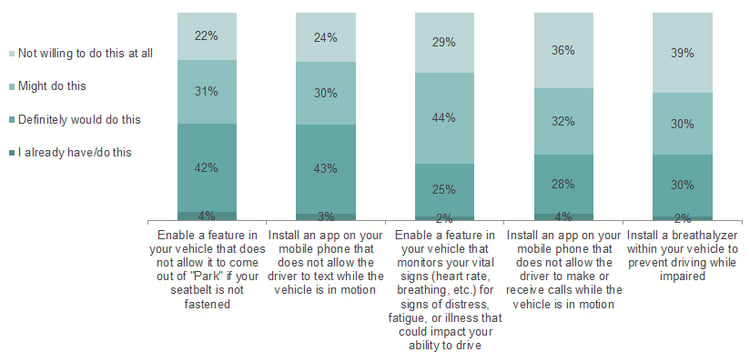While many consumers agree that using mobile phones while driving isn’t OK to do, the activity is perceived as only moderately dangerous compared to other distracted driving activities. According to a recent Lightspeed FSG study on Dangerous Driving Activities (2016), 45% of U.S. consumers agree completely that it’s never OK to use a mobile phone while driving (65% agree completely or slightly). More than half of respondents observed other drives using their phones while driving. And, older consumers are more likely to agree with this sentiment than younger consumers (37% of 25-34 year olds vs. 59% of those age 65+).
When rating activities on a scale of “Perfectly safe” (1) to “Very dangerous” (5), the worst driving activities were nodding off or falling asleep, watching video, reading a book or newspaper, and driving after consuming alcohol. (Interestingly, driving after drinking was rated most dangerous by 16-24 year olds, but those age 55 and up ranked that #4, less dangerous than falling asleep, watching video, or reading.) Singing along to music and talking to passengers are seen as the safest driving activities. Using a mobile phone falls almost directly in the middle among the 17 activities included in the exercise – but younger consumers feel it’s more dangerous than tending to a child or pet in the backseat or letting a pet sit on your lap while driving, while older consumers ranked those activities as more dangerous than using a phone.
Asked about specific mobile activities while driving, talking hands-free is perceived as least dangerous, while taking selfies or other pictures is most dangerous.
What can insurers do to curb distracted driving and increase the safety of everyone on the road? Participants were asked about their willingness to install apps or enable features within their vehicles that would ensure safe driving – and if they aren’t already using them, if they’d be more likely to consider them if they were offered a discount on their auto insurance.
How willing would you be to do the following?

While one in four consumers say they would not be willing to install an app on their phones that disables texting while their vehicle is in motion, 46% say they would definitely do this or they already use something like this. And if they got a discount on their insurance? 77% of those who say they’d definitely do it would be even more willing, and 74% who said they might do it would be more willing. Among the 24% who initially said they’re not willing to do it at all, 37% said they’d be more willing if they received an insurance discount for installing the app.
And while younger consumers are less likely to be willing to install a text suppression app, about two in three across the board – regardless of age – say they’d be more willing to use it for a discount on their insurance.
How do your customers perceive driving risks, and are they open to taking action to drive safer?





